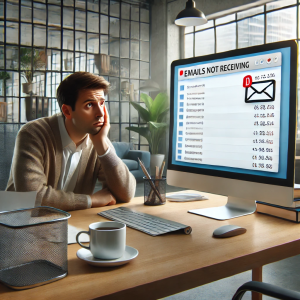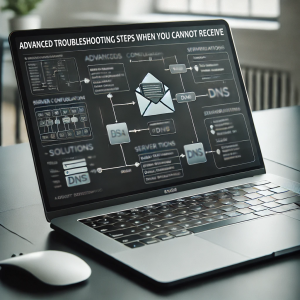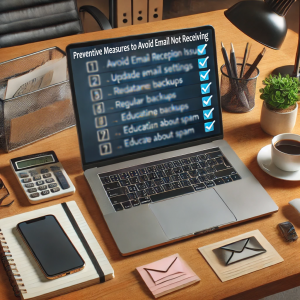Email Not Receiving
In modern digital world, email stands as a cornerstone of both personal and professional communication, seamlessly connecting the world at the click of a button. This instant, reliable method of correspondence is essential for daily interactions, business transactions, and maintaining personal relationships across distances. However, despite its integral role, many users frequently encounter a troubling issue of not getting emails.
This problem can manifest in various forms; some individuals find they cannot receive emails at all, while others are not receiving emails from one person. There are also common occurrences where important communications are missed because they end up in the spam folder, effectively making it seem like they are not getting emails. This issue can disrupt both work efficiency and personal connections, causing significant inconvenience and stress.
In this blog, we will delve into the prevalent problem of Email Not Receiving. We’ll explore various reasons when you might find yourself not receiving emails from one person or missing messages altogether. From identifying common causes to providing a detailed guide on both basic and advanced troubleshooting techniques, this blog aims to provide you with the knowledge and tools to address and rectify these issues. Furthermore, we’ll discuss preventive measures to ensure that your email communication remains fluid and uninterrupted, safeguarding against future instances of emails not being received.
By understanding these critical elements, you’ll be better equipped to tackle email reception problems head-on, ensuring that your digital communications run smoothly and efficiently. Stay tuned as we solve the mysteries behind email disruptions and learn how to keep your inbox accessible and functional.
Common Reasons for Not Getting Emails
Email is a vital communication tool, but various issues can hinder its functionality, leading to frustrations when you cannot receive emails. Understanding why you are unable to receive emails can help you solve the problem efficiently. Below, we explore the most common reasons for Email Not Receiving and provide actionable solutions to help you reclaim control over your inbox.
-
Emails Going to Spam Folder:
One prevalent issue is legitimate emails being mistakenly sent to the spam folder. This occurs because spam filters, which are designed to protect users from unwanted mail, sometimes misclassify good emails based on certain triggers and criteria. To manage this, regularly check your spam folder and adjust the filter’s sensitivity settings if you notice you’re not getting emails you expect. This ensures important communications do not go unnoticed and helps in understanding why you’re not receiving emails from one person or organizations.

-
Full Inbox:
Another typical scenario is a full inbox. Most email providers have a storage limit, and reaching this limit prevents new emails from being received. This situation is common in accounts where regular housekeeping isn’t performed. To mitigate this, regularly clear out old or unnecessary emails and be aware of your email provider’s storage limits. Periodically emptying the trash and spam folders can also free up space, ensuring you are not missing out on new messages because your email storage is full.
-
Incorrect Email Address:
Typos in email addresses are a simple yet significant barrier to effective communication. Sending an email to an incorrect address results in delivery failures, and you might never realize why your emails not being received unless the sender notifies you of the bounce-back. Always double-check addresses before sending important emails and confirm the recipient’s email address if you’re expecting a response that hasn’t arrived.
-
Email Filters and Rules:
Custom filters or rules created to organize incoming emails can sometimes reroute emails away from your primary inbox, causing confusion about not getting emails. To prevent this, review your filter settings to make sure emails are not being redirected to unexpected folders or being deleted. Adjust these settings as needed to make sure you receive all your intended emails directly in your main inbox.
-
Server Issues:
Finally, server issues can lead to delayed or lost emails. Whether due to server downtime, configuration errors, or network problems, these issues can prevent emails from arriving.
By understanding and addressing these common problems, you can significantly reduce instances where you are unable to receive emails. Regular maintenance of your email settings and being aware of the status of your email server will help ensure your communications remain uninterrupted and efficient.
Basic Troubleshooting Steps when you cannot receive Emails
When you find yourself frequently stating that you cannot receive emails, it can disrupt both your personal and professional life. To address the issue of Email Not Receiving, here are some basic troubleshooting steps that can help you pinpoint and resolve the issue efficiently.
Check Internet Connection
A stable internet connection is fundamental for receiving emails quickly. If you are experiencing issues with not getting emails, the first step should be to check your internet connectivity. To verify your connection:
- Test the speed of your internet using online tools to make sure you have adequate bandwidth for email communication.
- Start your router or modem again, as this can often resolve intermittent connectivity issues.
- Connect to a different network to rule out local network problems that might be affecting your email reception.
Verify Email Settings
Incorrect email settings are a common reason for not receiving emails from one person or multiple senders. To ensure your email account is set up correctly:
- Access your email settings via your email client or web interface.
- Confirm that your incoming server settings, IMAP settings, and SMTP settings are correctly configured according to your email provider’s guidelines.
- Check for any forwarding rules or filters that might be directing your emails to another folder or email address inadvertently.
Refresh or Update Email Client
Outdated email software can lead to compatibility issues and bugs that impact your ability to receive new emails. Ensuring that your email client is up-to-date is crucial for maintaining smooth email operations. To refresh or update your email client:
- Look for updates in your email client software and install any available updates to ensure you have the latest features and security patches.
- If issues continue, consider uninstalling and reinstalling the email client to resolve underlying problems that might be affecting its performance.
- Switch to a web-based email interface temporarily to determine if the problem is with your local email client or the email service itself.
By following these steps, you can often resolve common issues related to emails not being received. These steps are designed to tackle the most straightforward problems that might be blocking your email flow, from connectivity issues to client and configuration problems. Whether you’re facing difficulties with your IMAP server settings or simply need to ensure your internet connection is stable, these steps provide a foundation for getting your email communications back on track.
Advanced Troubleshooting Steps when you cannot receive Emails
When basic methods aren’t enough to solve your email reception issues, and you’re still saying that you cannot receive emails, it’s time to delve into advanced troubleshooting techniques. These methods are crucial for diagnosing and resolving deeper, less obvious problems that prevent emails from reaching your inbox.
DNS and Server Configuration Checks
Domain Name System (DNS) plays a critical role in the delivery of emails. It essentially directs the internet traffic to the right places, including emails to their proper destinations. Incorrect DNS settings can lead to Email Not Receiving issues. Here’s how to perform DNS and server configuration checks:
- Utilize tools like dig or nslookup to verify that your MX (Mail Exchange) records are set up correctly for your domain. MX records are essential for directing your emails to the right servers.
- Check your domain’s SPF (Sender Policy Framework) and DKIM (DomainKeys Identified Mail) records to ensure they are correctly specified. These configurations help prevent your outgoing emails from being flagged as spam, which can also affect incoming mail under certain circumstances.
- Regularly consult your hosting provider’s dashboard or support to ensure there are no service disruptions or maintenance activities affecting your incoming server settings or IMAP server settings.
Inspect Email Headers for Clues
Email headers contain crucial information that can help diagnose delivery issues. They provide a detailed path of the email’s journey from the sender to your inbox, making them invaluable for troubleshooting:
- Learn how to access and read email headers in your email client. Look for fields like “Received,” which trace the email’s path.
- Analyze the timestamps and server addresses listed in the headers to identify where delays or rejections might be occurring.
- Look for any discrepancies or anomalies in the headers that could indicate why you’re not receiving emails from one person or from multiple senders.
Use Dedicated Email Testing Tools
For a more thorough examination, several online tools can help diagnose email problems by providing insights into server health and configuration:
- Tools like MXToolbox offer comprehensive checks for your domain, including MX record verification, blacklist status, and more. These tools can identify critical issues that might be causing you to not get emails.
- Consider using email testing services that simulate sending and receiving scenarios to see how your email server responds and to ensure that all server settings are optimized for maximum deliverability.
- Regularly run these diagnostics to keep abreast of your server’s health and to preempt potential issues that might result in you unable to receive emails.
By employing these advanced troubleshooting techniques, you can address complex issues related to incoming server settings, IMAP server settings, and other intricate aspects of email delivery. This approach is particularly useful for IT professionals and business users who rely heavily on email for daily operations and require a high degree of reliability and performance from their email systems.
Preventive Measures to Avoid Email Not Receiving Issue
Maintaining a proactive approach to email management is essential to prevent common problems like not receiving emails from one person or from multiple senders. By adopting a few strategic preventive measures, you can make sure the reliability and security of your email communications.
Regularly Update Email Settings
To avoid issues where you cannot receive emails, it’s critical to keep your email client and server settings up-to-date:
- Make it a routine to check and update your incoming server settings, IMAP settings, and SMTP settings. This will ensure that they comply with the most current standards and technologies provided by your email service provider.
- Regular updates of your email software can prevent many problems related to emails not being received. These updates often contain crucial security patches and new features that enhance email delivery and reception.
- Maintain and periodically review your email filters and rules to ensure they are not improperly filtering out important emails, which is a common reason for not getting emails.
Educate About Spam Awareness
Understanding what constitutes spam and educating yourself and others on this can significantly reduce the risk of important emails being mistakenly notified as spam, a common reason for emails not being received:
- Conduct training sessions on recognizing spam indicators. This knowledge can help in setting up more effective spam filters that do not interfere with the receipt of legitimate emails.
- Follow best practices when crafting emails, such as avoiding known spam-trigger words in email subject lines and maintaining proper email formatting. This helps keep your emails from being flagged as spam, ensuring they are received by the intended recipients.
Backup Emails
Backing up your email data is a critical strategy for ensuring you do not lose access to your emails if problems arise with your email server:
- Use reliable email backup tools and services that regularly save your emails to a secure location, whether it’s cloud-based or on a local device. This is crucial for preventing loss of access to important communications in case of not getting emails due to server issues.
- Establish a consistent backup schedule that aligns with how frequently you use your email. Regular backups are especially important for businesses where email contains essential data.
- Fully understand the benefits and methods of email backups to choose the most appropriate backup solutions for your needs, safeguarding your email data against scenarios where you might find yourself not receiving emails from one person or any other sender.
By enhancing these preventive measures, you can effectively minimize the occurrences of not getting emails and improve your overall email management. Regular updates, informed spam handling, and diligent backups will not only secure your email communications but also ensure your inbox operates smoothly and efficiently.
FAQs
Q1. Why am I unable to receive emails from specific contacts?
- A. If you’re not receiving emails from one person, it’s possible their emails are being redirected to your spam folder or blocked by overly strict filters. Check your spam settings and any filters you’ve applied to ensure legitimate emails aren’t being misdirected.
Q2. What should I do if I cannot receive emails at all?
- A. If you cannot receive emails, verify your incoming server settings and IMAP settings. Make sure that your email client is configured correctly and that there are no disruptions with your email server.
Q3. Why might my emails not be received by others?
- A. If your emails are not being received, check if your IMAP server settings are correct and ensure that your email isn’t being marked as spam due to issues like SPF or DKIM misconfigurations.
Q4. How can I fix issues related to Email Not Receiving on my mobile device?
- A. For problems with Email Not Receiving on mobile, ensure that your IMAP settings and incoming server settings are configured similarly to your desktop settings. Also, make sure your mobile device’s software is up-to-date.
Q5. What are the first steps to take when I’m not getting emails?
- A. When you’re not getting emails, start by checking your internet connection, then review your email client’s spam folder, incoming server settings, and IMAP settings to ensure everything is set up properly.
Q6. How do server issues affect my ability to receive emails?
- A. Server issues can severely impact your ability to receive emails. If the server is down or experiencing delays, emails may not be delivered. Regularly check your email provider’s service status or contact their support if you suspect server problems.
Q7. What preventive measures can I take if I’m frequently unable to receive emails?
- A. To prevent situations where you are unable to receive emails, regularly update your IMAP settings and incoming server settings, keep your email client updated, and conduct frequent backups of your email data.
Q8. Why is it important to update my email client and server settings?
- A. Keeping your IMAP server settings and email client up-to-date ensures compatibility with email protocols and security standards, reducing the likelihood of issues where you cannot receive emails.
Q9. How can checking email headers help if I’m not receiving emails from one person?
- A. Email headers contain detailed route information and can help diagnose where the email may have been stopped or delayed. This can be particularly useful if you find that emails are not being received due to routing issues.
Q10. What tools can be used for diagnosing issues when emails are not being received?
- A. Tools like MXToolbox can be invaluable for diagnosing why emails are not being received. They check your domain’s MX records, blacklists, and server health, providing insights into potential delivery issues.
Conclusion
In conclusion, managing email communication effectively is crucial in our digitally connected world. Throughout this blog, we have explored a number of issues and solutions surrounding why individuals and organizations often find themselves saying that they cannot receive emails. From detailed discussions on incoming server settings to practical advice on IMAP server settings and IMAP settings, we’ve covered essential aspects that influence your ability to not get emails.
The significance of thoroughly troubleshooting when you are not receiving emails from one person or from multiple senders cannot be overstressed. Often, the issues are minor, such as incorrect incoming server settings or IMAP settings, and can be resolved with simple adjustments. However, when these problems persist, they require more detailed attention and possibly advanced solutions like checking IMAP server settings or conducting server configuration checks.
We want every user to participate fully in the solutions provided in this blog to enhance their email communication. Implementing the preventive measures discussed—regular updates of IMAP settings, educating yourself and others about spam, and backing up your email data—will significantly reduce the frequency and impact of issues related to Email Not Receiving.
By taking the initiative to understand and rectify common email issues, you can make sure that your communication remains uninterrupted and efficient. Remember, maintaining and regularly reviewing your incoming server settings and other related configurations will help safeguard against potential disruptions in your email service.
In essence, whether you are troubleshooting a current problem where you are not getting emails or taking steps to prevent future issues, the guidance provided here aims to foster healthier and more reliable email communications. Embrace these practices, stay informed, and continue to refine your approach to managing your email environment effectively.
To know more about our support services, go to our Homepage.
